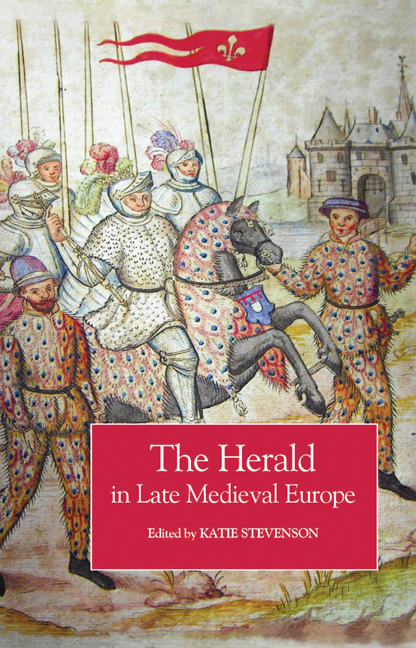Book contents
- Frontmatter
- Contents
- List of Illustrations
- Notes on Contributors
- Acknowledgements
- Abbreviations
- 1 Introduction
- 2 The Development of the Office of Arms in England, c. 1413–1485
- 3 Ancient Precedent or Tudor Fiction? Garter King of Arms and the Pronouncements of Thomas, Duke of Clarence
- 4 Jurisdiction, Authority and Professionalisation: The Officers of Arms of Late Medieval Scotland
- 5 The March of Brittany and its Heralds in the Later Middle Ages
- 6 City Heralds in the Burgundian Low Countries
- 7 King of Arms of the Ruwieren: A Special Function in the German Empire
- 8 Heraldry, Heralds and Politics in the Republic of Florence in the Late Middle Ages
- 9 Tournaments, Heraldry and Heralds in the Kingdom of Poland in the Late Middle Ages
- 10 A time when ‘fools and dwarfs were highly esteemed’? Seeking the Late Medieval Scandinavian Herald
- Index
6 - City Heralds in the Burgundian Low Countries
Published online by Cambridge University Press: 26 October 2017
- Frontmatter
- Contents
- List of Illustrations
- Notes on Contributors
- Acknowledgements
- Abbreviations
- 1 Introduction
- 2 The Development of the Office of Arms in England, c. 1413–1485
- 3 Ancient Precedent or Tudor Fiction? Garter King of Arms and the Pronouncements of Thomas, Duke of Clarence
- 4 Jurisdiction, Authority and Professionalisation: The Officers of Arms of Late Medieval Scotland
- 5 The March of Brittany and its Heralds in the Later Middle Ages
- 6 City Heralds in the Burgundian Low Countries
- 7 King of Arms of the Ruwieren: A Special Function in the German Empire
- 8 Heraldry, Heralds and Politics in the Republic of Florence in the Late Middle Ages
- 9 Tournaments, Heraldry and Heralds in the Kingdom of Poland in the Late Middle Ages
- 10 A time when ‘fools and dwarfs were highly esteemed’? Seeking the Late Medieval Scandinavian Herald
- Index
Summary
IN 1438, a delegation of the Damoiseaux brotherhood of the city of Valenciennes in Hainault made its entry during the annual jousts of the Épinette in the city of Lille. Savage men led the way, sounding horns and trumpets, followed by Franquevie, the herald of the city, wearing the coat of arms of Valenciennes, and also dressed up as a savage. Twenty-four gentlemen on horseback followed Franquevie in the procession and finally came a wagon with a large reproduction of Valenciennes, on which seven young ladies wore the arms of the city. This delegation was welcomed by the king of the Épinette, who stood in front of one of the town gates. Here, in this civic space, heralds participated in the symbolic representation of the city, wearing the arms of the city, accompanying its representatives, observing the celebratory jousts and hosting other heralds who were in attendance. For many years, officers of arms have been almost exclusively observed and described as a part of noble and chivalric culture. However, recent scholarly research has shown that towards the end of the Middle Ages heralds were integrated into some urban societies and civic hierarchies, particularly in the Burgundian Low Countries. The economic wealth of the Burgundian Netherlandish cities and their greater territories enabled the development of a festive culture, which became increasingly sumptuous during the fourteenth and the fifteenth centuries. Jousts and gatherings organised by the urban elites of these territories, from Hainault to Holland, show that as the Burgundian state made territorial acquisitions in these areas there was a simultaneous increase in civic activities and festivals. The takeover of these regions by the dukes of Burgundy is marked by the intervention of ducal power in urban festivals, where both urban heralds and those of the nobility were in close contact. Two cities in particular illuminate some of the issues of city heralds in the Burgundian Low Countries: Lille and Valenciennes. In these two cities, archival sources are very rich and demonstrate that the city heralds had an important place in civic administration.
- Type
- Chapter
- Information
- The Herald in Late Medieval Europe , pp. 97 - 114Publisher: Boydell & BrewerPrint publication year: 2009

